engine Acura TL 2001 3.2 Workshop Manual
[x] Cancel search | Manufacturer: ACURA, Model Year: 2001, Model line: TL, Model: Acura TL 2001Pages: 319, PDF Size: 3.85 MB
Page 212 of 319

Replace the engine oil f ill cap.
Start the engine. The oil pressure
indicator light should go out within
f ive seconds. If it does not, turn of f
the engine and reinspect your
work.
Let the engine run f or several
minutes and check the drain bolt
and oil f ilter f or leaks.
Turn of f the engine, let it sit f or
several minutes, then check the oil
level. If necessary, add oil to bring
the level to the upper mark on the
dipstick.
Refill the engine with the recom-
mended oil.
Engine oil change capacity
(including f ilter):
9. 8. 7.
6.
Engine Oil
Maint enance209
4.6 US qt (4.4, 3.9 Imp qt) Improper disposal of engine oil can be
harmf ul to the environment. If you
change your own oil, please dispose of
the used oil properly. Put it in a sealed
container and take it to a recycling
center. Do not discard it in a trash bin
or dump it on the ground.
Page 213 of 319
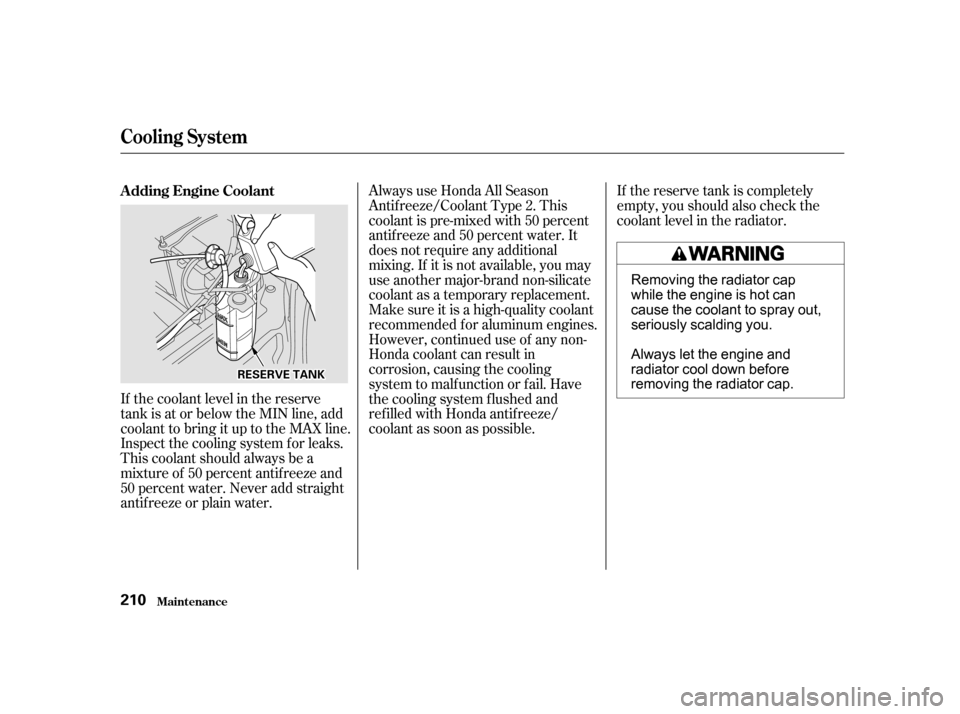
If the coolant level in the reserve
tank is at or below the MIN line, add
coolant to bring it up to the MAX line.
Inspect the cooling system f or leaks.
This coolant should always be a
mixtureof 50percentantifreezeand
50 percent water. Never add straight
antif reeze or plain water.If the reserve tank is completely
empty, you should also check the
coolant level in the radiator.
Always use Honda All Season
Antif reeze/Coolant Type 2. This
coolant is pre-mixed with 50 percent
antif reeze and 50 percent water. It
does not require any additional
mixing. If it is not available, you may
use another major-brand non-silicate
coolant as a temporary replacement.
Make sure it is a high-quality coolant
recommended f or aluminum engines.
However, continued use of any non-
Honda coolant can result in
corrosion, causing the cooling
system to malf unction or f ail. Have
the cooling system f lushed and
ref illed with Honda antif reeze/
coolant as soon as possible.
A dding Engine Coolant
Cooling Syst em
Maint enance210
R RE
ES
SE ER
RV V E
E T
TA
A N
NK K
Removing the radiator cap
while the engine is hot can
cause the coolant to spray out,
seriously scalding you.
Always let the engine and
radiator cool down before
removing the radiator cap.
Page 214 of 319

CONT INUED
Turn the radiator cap counter-
clockwise, without pressing down
on it, until it stops. This relieves
any pressure remaining in the
cooling system. Make sure the engine and radiator
are cool.Remove the radiator cap by
pushing down and turning
counterclockwise.
The coolant level should be up to
the base of the f iller neck. Add
coolant if it is low.
Put the radiator cap back on.
Tighten it f ully.
3.
1.
2. 4.
5.
Cooling Syst em
Maint enance211
R RA
A D
DI
IAA T
TO
OR R C
CAA P
P
Page 215 of 319
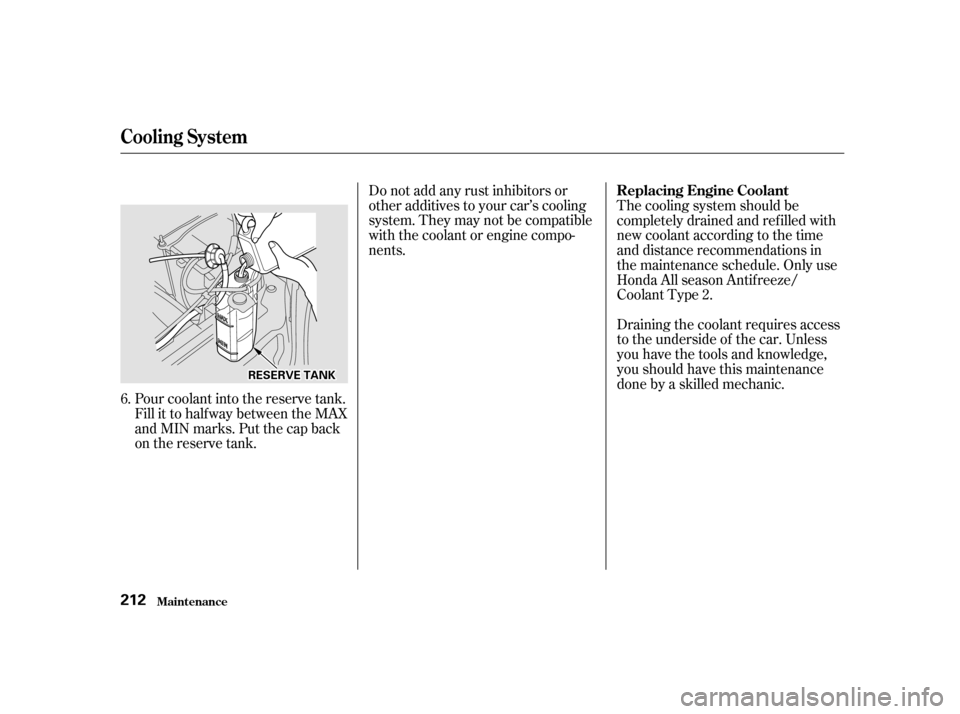
Pour coolant into the reserve tank.
Fill it to half way between the MAX
and MIN marks. Put the cap back
on the reserve tank.Do not add any rust inhibitors or
other additives to your car’s cooling
system. They may not be compatible
with the coolant or engine compo-
nents.
Draining the coolant requires access
to the underside of the car. Unless
you have the tools and knowledge,
you should have this maintenance
done by a skilled mechanic. Thecoolingsystemshouldbe
completely drained and ref illed with
new coolant according to the time
and distance recommendations in
the maintenance schedule. Only use
Honda All season Antif reeze/
Coolant Type 2.
6. Replacing Engine Coolant
Cooling Syst em
Maint enance212
R RE
ES
SE ER
RV V E
E T
TA
A N
NK K
Page 216 of 319
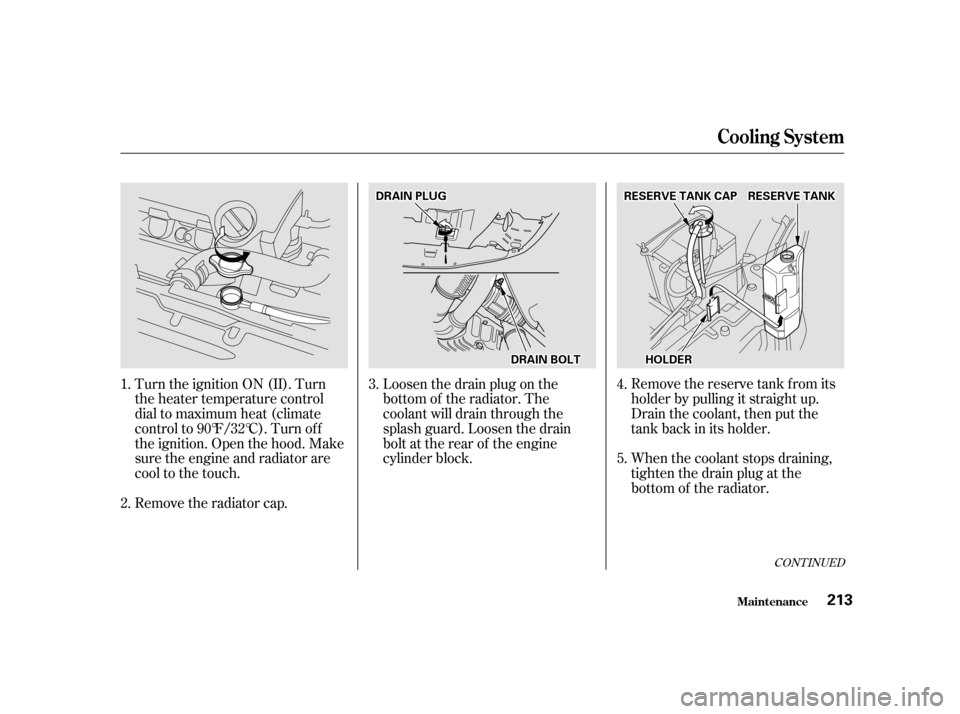
CONT INUED
Remove the reserve tank f rom its
holder by pulling it straight up.
Drain the coolant, then put the
tank back in its holder.
When the coolant stops draining,
tightenthedrainplugatthe
bottom of the radiator.
Loosen the drain plug on the
bottom of the radiator. The
coolant will drain through the
splash guard. Loosen the drain
bolt at the rear of the engine
cylinder block.
Turn the ignition ON (II). Turn
the heater temperature control
dial to maximum heat (climate
control to 90°F/32°C). Turn of f
the ignition. Open the hood. Make
sure the engine and radiator are
cool to the touch.
Remove the radiator cap. 3.
1.
2. 4.
5.
Cooling Syst em
Maint enance213
D D
R
RAA I
INN P
PL
LUUG G R
REES
SE ER
RV V E
E T
TA
A N
NK K C
CAA P
P
H
H O
OL LDD E
ER
R R
RE
ES
SE ER
RV V E
E T
TA
A N
NK K
D
D R
RAA I
INN B
BOOL LTT
Page 217 of 319
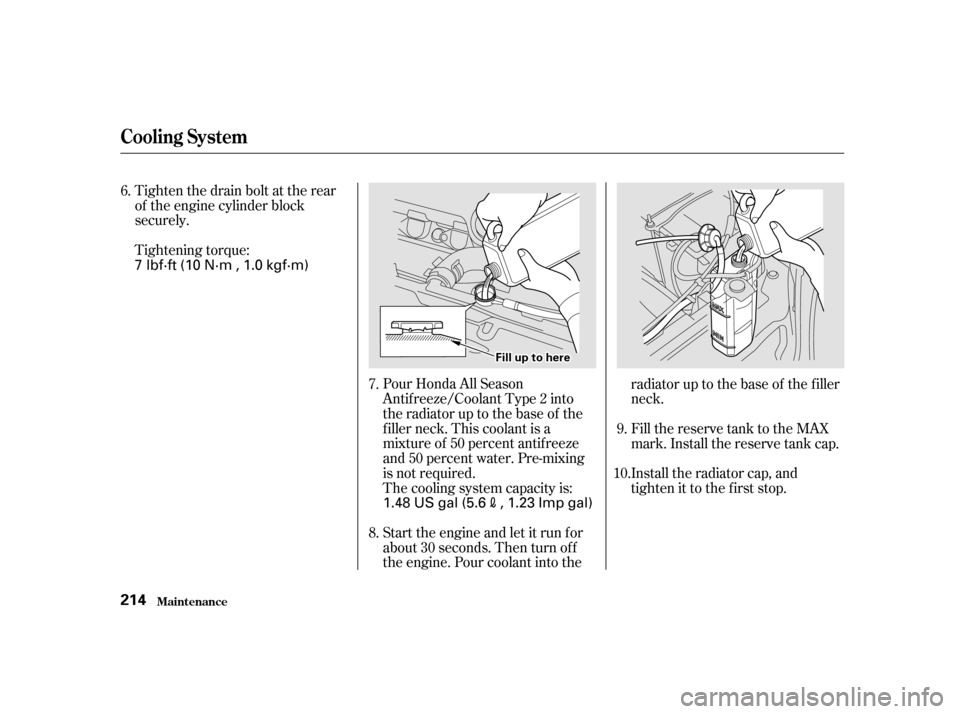
Tighten the drain bolt at the rear
of the engine cylinder block
securely.
Tightening torque:Pour Honda All Season
Antif reeze/Coolant Type 2 into
the radiator up to the base of the
f iller neck. This coolant is a
mixture of 50 percent antif reeze
and 50 percent water. Pre-mixing
is not required.
The cooling system capacity is:
Start the engine and let it run f or
about 30 seconds. Then turn of f
the engine. Pour coolant into theradiator up to the base of the f iller
neck.
Fill the reserve tank to the MAX
mark. Install the reserve tank cap.
Install the radiator cap, and
tighten it to the first stop.
6.
8.9.
7.
10.
Cooling Syst em
Maint enance214
F Fiillll u
u p
p t
too h
he
erree
7 lbf·ft (10 N·m , 1.0 kgf·m)
1.48 US gal (5.6
, 1.23 Imp gal)
Page 218 of 319

If necessary, f ill the reserve tank
to the MAX mark. Install the
reserve tank cap.
Install the radiator cap, and
tighten it fully. Start the engine and hold it at
1,500 rpm until the cooling f an
comes on. Turn of f the engine.
Check the coolant level in the
radiator and add coolant if needed. Remove the radiator cap. Pour
coolant into the radiator up to the
base of the f iller neck and into the
reserve tank up to the MAX mark. Start the engine and let it run until
the radiator cooling f an comes on
at least twice. Then stop the
engine. Check the level in the windshield
washer reservoir at least monthly
during normal usage. In bad weather,
when you use the washers of ten,
check the level every time you stop
for fuel.
The windshield washer reservoir is
located behind the passenger’s side
headlight.
15.
14. 13. 12.
11.
CONT INUED
Maint enance
Cooling System, Windshield Washers
Windshield Washers
215
Page 219 of 319
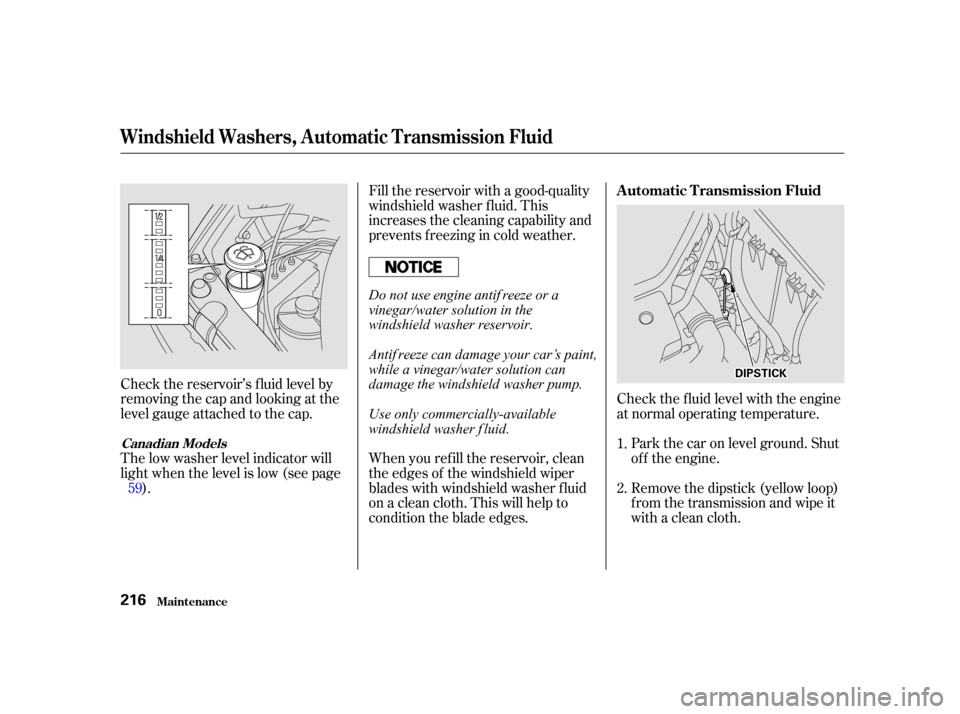
Check the f luid level with the engine
at normal operating temperature.Park the car on level ground. Shut
of f the engine.
Remove the dipstick (yellow loop)
f rom the transmission and wipe it
with a clean cloth.
Fill the reservoir with a good-quality
windshield washer f luid. This
increases the cleaning capability and
prevents f reezing in cold weather.
When you ref ill the reservoir, clean
the edges of the windshield wiper
blades with windshield washer f luid
on a clean cloth. This will help to
condition the blade edges.
Check the reservoir’s f luid level by
removing the cap and looking at the
level gauge attached to the cap.
The low washer level indicator will
light when the level is low (see page
). 1.
2.
59
Maint enance
Windshield Washers, A ut omat ic T ransmission Fluid
Automatic Transmission Fluid
Canadian Models
216
D D I
IPP S
ST TI
ICCK K
Do not use engine antif reeze or a
vinegar/water solution in the
windshield washer reservoir.
Antif reeze can damage your car’s paint,
while a vinegar/water solution can
damage the windshield washer pump.
Use only commercially-available
windshield washer f luid.
Page 222 of 319

Check the level when the engine is
cold. Look at the side of the
reservoir. The f luid should be
between the UPPER LEVEL and
LOWER LEVEL. If it is below the
LOWER LEVEL, add power steering
f luid to the UPPER LEVEL.Always use Honda Power Steering
Fluid. If it is not available, you may
use another power steering f luid as
an emergency replacement.
However, continued use can cause
increased wear and poor steering in
cold weather. Have the power
steering system f lushed and ref illed
with Honda PSF as soon as possible.
A low power steering f luid level can
indicate a leak in the system. Check
the f luid level f requently and have
the system inspected as soon as
possible.
Clean the hood latch assembly with a
mild cleaner, then lubricate it with a
multipurpose grease. Lubricate all
the moving parts (as shown),
including the pivot. Follow the time
and distance recommendations in
the Maintenance Schedule. If you
are not sure how to clean and grease
the latch, contact your Acura dealer.
Maint enance
Power Steering Hood L atch
Power Steering, Hood L atch
219
M MA
AX
X
M
M I
INN L
LA
A T
TC
CH H
A
A S
SSSEEM
M B
BLLYY
T urning the steering wheel to f ull lef t
or right lock and holding it there can
damage the power steering pump.
Page 223 of 319

Place the new air cleaner element
in the air cleaner housing.
Reinstall the air cleaner housing
cover, tighten the four bolts.
The air cleaner element should be
cleaned or replaced according to the
time and distance recommendations
in the maintenance schedule.
Clean the air cleaner element by
blowing compressed air through it in
the opposite direction to normal air
f low. If you do not have access to
compressed air (such as a service
station), ask your Acura dealer to do
this service.
Follow the replacement procedure
for removal and reinstallation.
The air cleaner element is inside the
air cleaner housing on the driver’s
side of the engine compartment.
To replace it:
Loosen the f our bolts by using a
Phillips-head screwdriver and
remove the air cleaner housing
cover.
Caref ully clean the inside of the
air cleaner housing with a damp
rag. Remove the old air cleaner
element.
1.
3. 4.
5.
2.
Maint enance
A ir Cleaner Element
Cleaning (Severe Conditions)
Replacement
220
A A I
IRR C
CLLEE A
A N
NE ER
R E
EL
LEE M
M E
EN
NT T
B
BO
OL LTT S
S